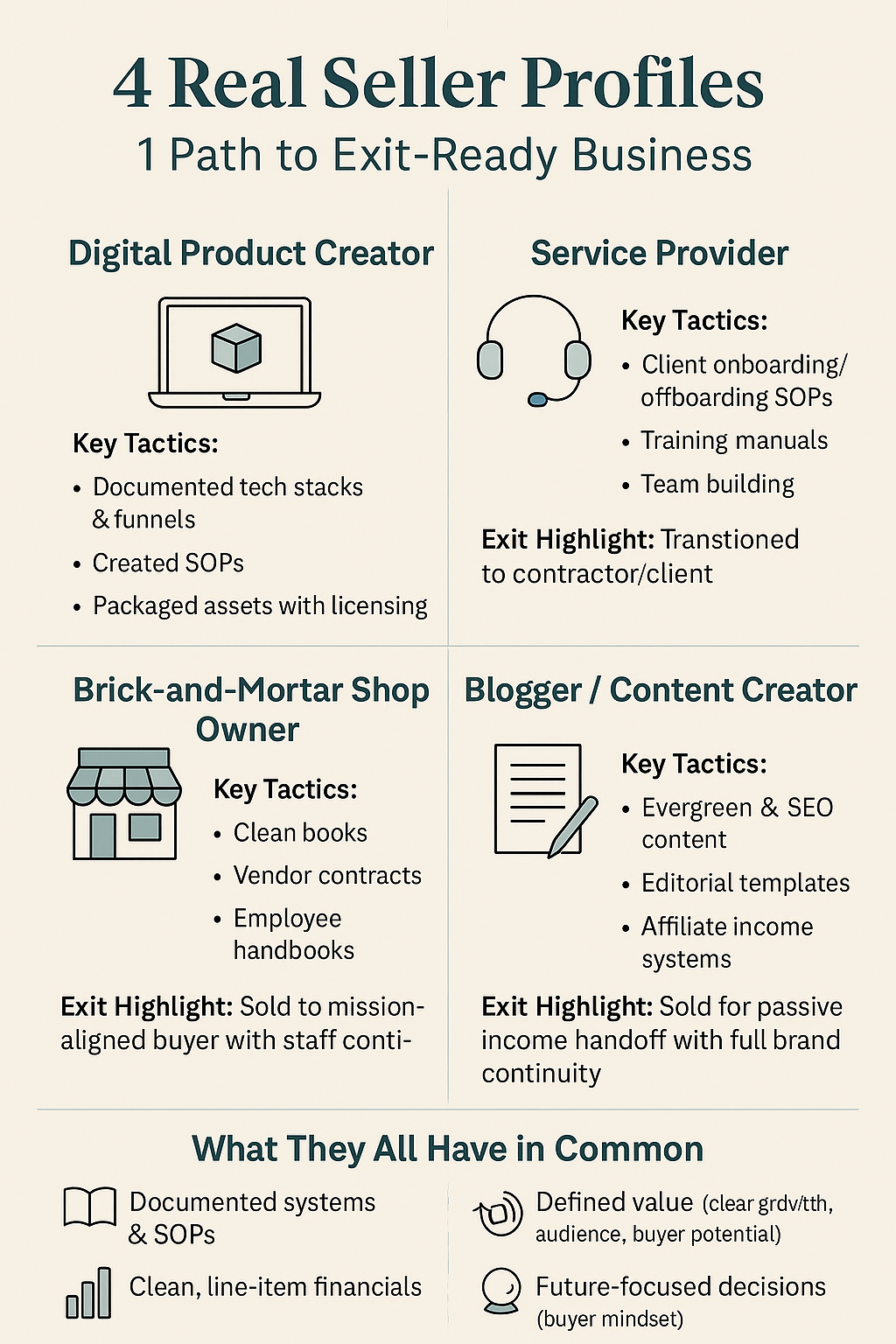4 Seller Profiles: How These Business Owners Built Sellable Brands
Not every small business is built with an exit strategy from day one—but the smartest owners know that any business can become sellable with the right systems, structure, and mindset.
Whether you’re a creative entrepreneur, service provider, blogger, or brick-and-mortar owner, your business has value beyond your day-to-day work. Below, we’re diving into four real-world seller profiles—different paths, different models, same end goal: a smooth and meaningful transition.
1. The Digital Product Creator: Building to License or Sell
Profile:
This business owner creates online products—think courses, templates, memberships, or eBooks. Over time, they develop repeatable marketing systems (like email funnels and ad strategies), build an engaged audience, and create a clear licensing or resale model.
How they made it sellable:
Documented all tech stacks, funnels, and automations
Created SOPs for updating products and customer support
Organized financials by product line to show profitability
Packaged digital assets with licensing terms that allow reuse
Exit strategy:
They sold the business to a younger creator in the same niche who wanted to skip the build-from-scratch stage. Because of the clean systems and proven sales history, the new owner was able to step in, rebrand slightly, and keep the revenue flowing from day one.
Legacy takeaway:
Digital doesn't mean disposable. Systems and structure create real resale value—even when there’s no physical product.
2. The Service Provider: From Solo to Sellable
Profile:
This business owner runs a service-based company—like coaching, consulting, graphic design, or bookkeeping. Instead of doing everything themselves forever, they slowly begin building systems, documenting their process, and mentoring someone to eventually take over.
How they made it sellable:
Created client onboarding/offboarding SOPs
Turned repeatable service steps into a training manual
Built out a small team or contractor network
Delegated gradually to test independence before selling
Exit strategy:
They sold the business to a trusted junior contractor or even a past client. Since the services, clients, and tools were already familiar, the transition felt seamless—and clients didn’t experience any drop in quality or care.
Legacy takeaway:
Even solo-driven businesses can be sold. The key is documenting your “magic” so someone else can deliver the same value.
3. The Brick-and-Mortar Shop Owner: Selling with Community at Heart
Profile:
This owner runs a retail or local service business—like a boutique, cafe, or fitness studio. Their secret weapon? Deep community roots, loyal customers, and a team that genuinely loves the business.
How they made it sellable:
Kept financials clean and categorized
Maintained strong vendor relationships and vendor contracts
Created employee handbooks, training manuals, and schedules
Involved the team in planning the transition early
Exit strategy:
They sold the business to a mission-aligned buyer—often a local entrepreneur or customer—who wanted to keep the brand intact. Because the books were in order and the team was stable, the buyer saw immediate value and long-term potential.
Legacy takeaway:
A strong local brand can be incredibly appealing to buyers—especially when it’s built on systems, not just sentiment.
4. The Blogger: From Personal Project to Sellable Platform
Profile:
This content creator built a blog based on personal stories, passion, or niche expertise—think parenting, travel, or wellness. Over time, the blog developed evergreen content, SEO traffic, affiliate income, and maybe even digital products.
How they made it sellable:
Converted personal stories into evergreen, search-optimized posts
Created content templates and an editorial calendar
Built consistent affiliate income and diversified monetization
Removed overly personal branding or created a transition plan for rebranding
Exit strategy:
They sold the blog to another blogger, agency, or niche site buyer who saw the potential for growth and passive income. The handoff included all branding assets, affiliate accounts, content libraries, and SOPs for ongoing publishing.
Legacy takeaway:
Blogs aren’t just personal diaries—they can be powerful digital assets when structured with consistency and clarity.
What These Sellers Have in Common
While each of these business owners came from very different models, they all shared a few key things that made their businesses sellable:
Documented systems: Whether service-based or product-based, they wrote things down, created templates, and trained others.
Clean financials: They tracked income, expenses, and profitability in a buyer-friendly format.
Defined value: They could explain what made their business work—and how someone else could continue or improve it.
Forward thinking: They made decisions with their future self—or a future buyer—in mind.
Final Thoughts: What Kind of Seller Will You Be?
You don’t have to fit one of these profiles exactly—but you can start thinking like a future seller today. Ask yourself:
Could someone else step in and run this business without me?
What do I need to document to make that possible?
What kind of buyer might want this someday—and what would they need to see?
Whether you want to sell in two years or ten, building your business with these strategies in mind gives you freedom, options, and a legacy that lasts.






























Not every business is sellable. And just because a business makes a profit, does someone want to buy it. So much plays into the sale of business. At the end of the day, you are selling a job. Here are 10 tips to add value to your biz and get it sold.